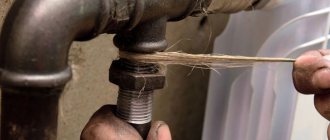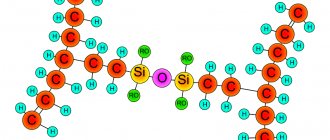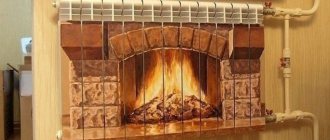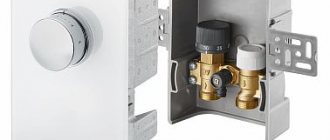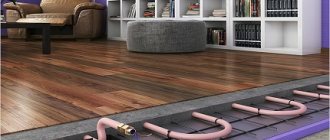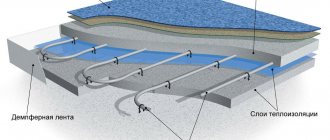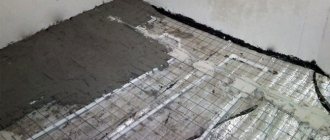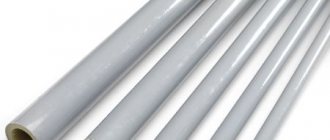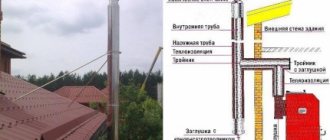The socket method of laying a pipeline is considered the easiest and most reliable; it does not require special knowledge; for this you need to have a minimum of necessary tools.
What is the difference between a pipe with a socket and a regular pipe?
A socket is a funnel-shaped expansion of a pipe at one end that serves to provide lightness and strength to the butt seams of structural elements. The second end of the bell is smooth.
Bells are made from the following materials:
- - made of PVC
- - made of concrete
- - made of cast iron
- - made of ceramics
- -of steel
The specificity of connecting socket pipes comes down to the fact that the smooth edge of the pipe is inserted into the socket extension of another pipe and secured. If the design requires it, then the joints are sealed, taking into account the material of the elements. The sockets are used in different diameters, so rubber and metal rings are used to seal the joints.
What are sockets used for:
- 1.To simplify installation work and reduce pipe laying time.
- 2. Providing additional sealing to pipes.
- 3.Providing the connecting structure of pipe and fitting.
- 4. The ability to lay a water supply network assembled from sockets of different materials without using fittings.
- 5.To stiffen the ribs.
- 6.Easy to dismantle and replace parts of the structure.
Important! The pipeline with a socket has a collapsible design; if necessary, only part of the system can be dismantled and reassembled.
Cast iron pipelines
When assembling a pipeline from cast iron elements, caulking or resistance welding is used to seal the socket. The fact is that these pipes have a larger socket diameter, so the gap after the connection remains wide. Therefore, the use of sealant cannot provide a sufficient level of sealing.
Caulking
To perform caulking, fibrous materials are used - sanitary tow, flax. As a last resort, you can use pieces of linen or cotton fabric. In addition, cement mortar or bitumen mastic is used.
Advice! Caulking is a very reliable method of sealing. If the work is done correctly, then the occurrence of leaks in this area is minimal.
Carrying out work:
- If possible, caulking should be carried out with the pipe positioned vertically;
- first you need to take measurements, marking on the smooth end of the part the depth of its entry into the socket;
- Having retreated 3 cm from the marked line, you need to begin winding the fiber seal towards the end of the part;
- the wrapped end is inserted into the socket;
- to compact the winding, you need to use a chisel;
- A cement mortar is prepared from PVA glue, water and dry cement; it should turn out liquid so that it can be poured, filling the gap in the socket. It is more convenient to pour using a funnel;
- then you need to give the solution time to harden, so you won’t be able to use the pipeline for at least a day.
Contact welding
This method is used infrequently, although it provides 100% protection against leaks. This method is not used because of its complexity, since it is almost impossible to perform without being a specialist. Work order:
- First, the work described above is carried out, that is, the bell is caulked. But you need to make sure that the level of the solution does not reach the edge by about 1 cm;
- then you need to wait until the solution has completely hardened and only then start welding;
- The welding mixture is applied to the edge of the socket, then the resistance welding process is carried out.
Where are socket structures used?
The socket installation method is used in various areas. The sewer system and storm drains require the use of special pipes. Pipes with sockets are an economical option for laying a plumbing system, are durable, and are easy to install.
Pipes are used:
1. During the construction of residential buildings and industrial facilities.- 2.Hydraulic works.
- 3. During road construction.
- 4.During the laying of railway tracks.
- 5.In agriculture.
Bell pipe structures are made from concrete, plastic, and cast iron. Pipes of different materials have their own characteristics and applications.
Types of sockets for sewerage
Pipes assembled from sockets are easy to install, durable in use and cost-effective.
The most common type of socket is a concrete pipe. The larger the cross-section of the pipe, the lower its cost. The concrete socket is very durable and practical for use. One end of the socket has an extension for attaching another part to it. The joints are sealed in the most appropriate way.
Reference! Joints of pipes made of cast iron or concrete are sealed using concrete-resin compounds containing a special filler, and plastic ones are sealed using rubber gaskets in the form of rings.
To seal joints made of cast iron and concrete, a rubber cuff is sometimes used, which increases the tightness of the joints, ensuring the waterproofness of the product.
Attention! Flared water pipes are laid against the main movement of waste water.
Sockets made of cast iron and plastic are used when installing water supply and sewerage networks in premises. Concrete products are suitable for external sewer systems. External sewage requires the use of pipes with a wide diameter, through which large flows of waste flow freely.
Socketless pipe structures
Pipes without sockets are also popular, durable and practical to use. The pipes are connected using special elements that can ensure the tightness of the structure.
In railway construction, a concrete flange is used to seal joints, and a clamp is used to connect cast iron pipes. In some situations, it is better to use socketless structures to simplify installation work and save time. Such pipes are used in non-pressure sewer systems. If the connections are equipped with sealing collars, the pipes can be used in pressure systems, withstanding high intra-pipe pressure.
The area of widespread application of socketless construction is drainage systems and sewerage systems without the use of sockets.
Features of concrete sockets
Concrete sockets are used for the construction of houses and industrial facilities. They are distinguished by practicality, durability, long service life, and cost-effectiveness.
With the help of concrete structures, sewerage systems, storm drain systems, and overflow pipeline systems are laid during road construction.
Concrete sockets are used:
1.in a non-pressure system.- 2.in a pressure system.
- 3.in all types of road construction.
In industry, sockets of the T, TB and TV types are used.
For each type, GOST provides individual parameters for the manufacturing method, load volume and area of use.
Pipes of type T are intended for laying non-pressure systems, laid in sewers, drainage of waste water by ground, underground methods, as well as other liquids that the pipes can withstand. They provide greater water permeability and are inexpensive to manufacture and install.
TB type sockets are used for sewers with increased load. The sockets can be initially equipped with rubber rings for sealing, reducing installation time and increasing the tightness of the product.
Important! The sockets ensure the passage of any liquid through the pipeline under pressure.
The most common sockets in use are five meters long, the pipe cross-section is one meter, and the wall thickness is seventy-five millimeters. They are practical for installing sewer collectors and can withstand the optimal load when five cars travel on a special platform.
TV type sockets are used in road construction. The sockets have increased strength, are sealed with rubber gaskets, and can withstand increased soil pressure and road surface loads.
Technical characteristics are divided into the following groups:
- 1. group that can withstand the pressure of filled soil and road surface with a height of no more than five meters.
- 2. group that can withstand a load of no more than ten meters.
- 3.group with a possible load of no more than 15 meters.
- 4. group that can withstand a backfill thickness of no more than twenty meters.
A pipe with a concrete socket is intended for sewerage and has a rigid, durable structure. The service life is over fifty years. The sockets are manufactured using high technology from durable material with surface reinforcement. For concrete sockets, the quality and price of the products correspond to each other, which is why many organizations choose these products when laying sewers.
Sockets made of cast iron and plastic
Along with concrete structures, pipes made of cast iron and plastic are widely used. Cast iron structures are used in the construction of drainage and sewer networks. As a rule, sockets made of cast iron and plastic are installed during the installation of intra-house sewer systems and drainage systems.
Cast iron products protect cables laid underground well. The bells resist fire, protect against excessive moisture and mechanical damage. To prevent freezing, the pipes are covered with a layer of geofabric. The disadvantage of the design is that cast iron is susceptible to corrosive changes. To ensure that the pipes last a long time, the pipeline is subjected to anti-corrosion insulation.
Plastic bells are displacing cast iron products from everyday use. Plastic sewerage elements are almost weightless, practical to use, have the characteristics of cast iron pipes, but are inferior to them in strength. Plastic structures are made of polyvinyl chloride, polypropylene, polyethylene of different pressures.
They are also used for laying sewerage and drainage systems, but the material limits the scope of the pipes. Socket joints are laid using a rubber seal to ensure sealing. Sometimes a welded connection of elements is used. Pipes are made in different colors, which conveys information about their purpose in the pipeline system and also increases the aesthetic appearance of the structure.
Important! Plastic resists corrosive processes.
Installation methods
It may seem that socket technology for connecting pipeline sections is the only option that ensures the tightness of the system. However, there are other methods. They are selected taking into account the type of material from which the communications are made. If this factor is not taken into account, the reliability of installing a socket sewer pipe will significantly decrease. You will have to regularly repair the system to eliminate leaks. Such problems can be avoided if installation is carried out in accordance with the instructions.
Adhesive connection
This option can only be used when laying polymer pipes, in particular PVC products. This is due to the fact that such a material has a structure different from its metal counterparts. When performing installation, it is necessary to use a special glue for polymer communications. You need to work with such a composition carefully, because... it instantly glues the elements together. After installation, water must not be supplied to the system for 1 day.
Instructions for performing the work:
- To increase adhesion, the smooth end of the pipe is treated with sandpaper.
- Special glue is applied at a distance of at least 2 cm from the end.
- It is necessary to immediately connect 2 parts, because the composition sets quickly.
- You should hold the pipeline section for several seconds, pressing the 2 pipes tightly against each other.
- The glue sets in 1.5 minutes.
If you test the system immediately after gluing the communications, the quality of the connection will decrease. Soon a leak may appear in this area.
Connection using a rubber ring
The use of products with a socket requires the need to ensure tightness. This condition is difficult to fulfill if the rubber sealing ring is not used during installation. Thanks to it, the required level of reliability is ensured and the service life of the structure is extended. In most cases, a rubber ring is offered along with communications. If you purchased an incomplete product, you can purchase the seal separately.
There is a groove for installing the rubber ring. It runs along the entire length of the communications circle. The seal must be placed in the groove. Moreover, you should carefully check the quality of installation: the ring should fit tightly to the walls of the communications; if waves are formed, it means that the wrong element was purchased. After installing the seal, you can connect sections of the pipeline - a smooth end is inserted into the socket. Additionally, it is recommended to apply silicone sealant on top along the entire circumference of the installation seam.
Assembly with cement
This method is called caulking; It is suitable for steel, cast iron, ceramic, asbestos concrete, reinforced concrete products. This technology is used when the gap between the walls of the socket and the smooth section of communications is large enough. In addition, caulking is used to join products made from different materials.
Operating procedure:
- Prepare a linen sealant. Prepare a solution of cement and water. The components are taken in a ratio of 9:1.
- Then you need to fill the gap between the socket and the smooth end with linen sealant. It is compacted using a screwdriver or a narrow spatula. The leak is filled to 2/3 of the length.
- At the last stage, the seam is sealed with cement mortar.
The system is tested no earlier than after 1 day.
Welding pipe connection using the socket method
This technology is considered an auxiliary measure. It is used for installation of cast iron products, but only after caulking has been completed. First, the gap at the junction of the sewer pipe and the socket is sealed with linen material, then cemented using the previously discussed method. Moreover, you need to leave 1-2 cm from the edge of the bell free. Welding is performed in this area.
Where are sockets used?
Designs with a socket are used in the pipeline system for pressure and non-pressure passage of wastewater through pipes. Reinforced concrete products are used for laying an external sewer system, which requires structural elements with a large cross-section, and for the arrangement of storm drains on city streets. Plastic and cast iron products have the same areas of application on a smaller scale, in private and apartment buildings, and civil facilities.
Bells are used to protect cable wires and heating mains. All types of pipes are resistant to large differences in ambient temperatures, pressure from top soil filling, and road surfaces. The tightness of the pipeline guarantees optimal pressure inside the pipes with which the liquid flows through the sewerage system.
